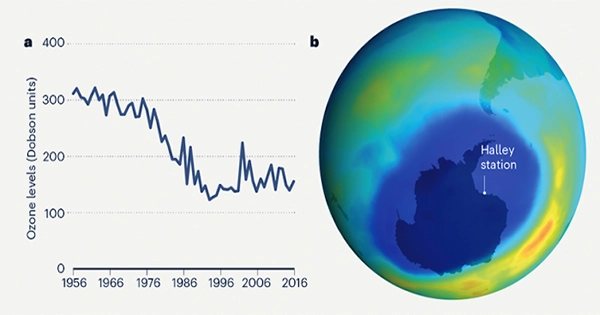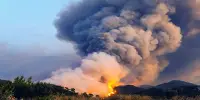On October 5, the area of the ozone hole above Antarctica reached its yearly maximum of 26.4 million square kilometers (10.2 million square miles). The ozone hole has grown to this magnitude for the third year running, although the long-term trend indicates that it is still becoming smaller.
Paul Newman, chief earth scientist at NASA Goddard Space Flight Center, stated that “all the data shows that ozone is on the mend.” The hole normally widens between August and October, but according to Newman, this year “it’s a little worse because it was a little cooler this year.”
Chlorine compounds high in the stratosphere, the majority of which can be linked to the previous use of chlorofluorocarbons, are responsible for the ozone depletion over the southern polar area (CFCs). Polar stratospheric clouds (PSCs) can form at great heights during the bitterly cold Antarctic winter. The chemical reactions that transform CFCs into more useful forms, such chlorine gas, then take place on the surface of these PSCs.
At the start of the polar spring, UV radiation caused by the return of sunlight separates these chlorine gas molecules, releasing chlorine atoms that then interact with and destroy ozone molecules. Because of this, the Antarctic ozone hole always widens in the spring before stabilizing when the temperature rises too much for PSCs to exist.
As a result, the risk of damage increases with springtime temperature, which explains why recent years have seen exceptionally large ozone gaps.
For instance, this year’s stratospheric temperatures peaked on August 11 at 179 Kelvin (-94 degrees Celsius), but by October 11 had risen to 191 Kelvin (-82 degrees Celsius). Importantly, the latter figure is still below the minimum temperature necessary for PSC production.
By October 11, according to NASA’s measurements of the ozone hole, it had returned to its original size of 22.67 million square kilometers (8.75 million square miles). On October 1, ozone over the southern polar region had a minimum thickness of 97 Dobson units, but ten days later it had increased to 105 Dobson units.
For comparison, the ozone layer that surrounds the Earth has a typical thickness of 220 Dobson units. Values below this threshold have never been recorded in Antarctica before 1979, and they are always linked to the loss of the ozone layer caused by CFCs.
Fortunately, the Montreal Protocol of 1987, which forbade the use of CFCs, has played a significant role in the ozone layer’s recovery during the past few decades. The size of the hole has steadily shrunk since it peaked at an all-time high of 29.9 million square kilometers (11.5 million square miles) in September 2000, despite annual levels fluctuating.
However, while the unusually large ozone hole this year is likely entirely the result of freezing temperatures, others believe that firms in China may have used CFCs illegally to some extent. According to Brian Toon of the University of Colorado, there may also be a connection between the recent eruption of an undersea volcano in Tonga and huge forest fires in Australia.
















